Projects Overview
OK International makes small grants and provides technical assistance to non-governmental organizations (NGOs) in the developing world to address environmental disease linked to industrial pollution. The success of these projects has attracted significant financial resources for our partners to pursue their objectives. With additional support from OK International, these projects can be replicated to address the same harmful exposures in additional communities. Below are some examples from our work in Nigeria, India, Vietnam, China, Kosovo, Cameroon and Peru, that have helped build capacity to respond to these issues around the globe.
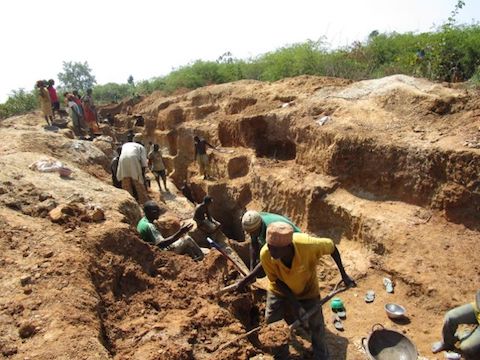
Gold miners in Nigeria have encountered ore with lead concentrations ranging up to 10% by weight. Safer mining practices are working to minimize exposures and reduce the risk of taking home lead to their homes and villages.
Promoting Safer Mining Practices in Nigeria
OK International conducted a five-year pilot project in partnership with Doctors Without Borders/ Médecins Sans Frontières (MSF) to respond to widespread and severe lead poisoning from small-scale gold mining in areas of Northern Nigeria. Since 2010 MSF has responded to the high infant mortality rate linked to lead poisoning in this area and has monitored and treated thousands of poisoned children. Over time it has become apparent that the remediation of lead contamination and the treatment of lead poisoning will not be sustainable without also improving mining practices in these communities to reduce exposures and minimize off-site contamination.
Lead is present in the gold ore in substantial concentrations in several areas of Nigeria and processing this material results in significant exposures and environmental contamination. Environmental remediation to remove contaminated soil and dust has been completed in select communities. MSF and OK International have now partnered to work cooperatively with the miners in these areas to introduce safer work practices in order to reduce lead and silica dust exposures to miners and children.
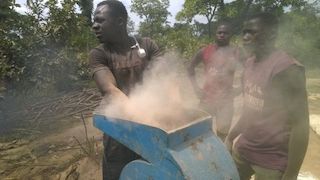
Mine processing to crush gold ore releases significant concentrations of airborne lead and silica dust. This miner is wearing an air monitoring device to measure his exposure. Wet processing techniques have been introduced to reduce exposures.
These interventions include training miners to implement simple practices to reduce exposures with improved personal hygiene practices and setting up separate eating and changing areas. We are also introducing wet methods to reduce exposures in the processing of ore.
In addition, mercury is widely used for small-scale gold processing in Nigeria. This results in extensive environmental contamination and worker exposure to mercury. This project will explore opportunities to replace mercury, or reduce the use and resulting exposures, with improved mercury capture techniques.
Our efforts to introduce safer mining practices has been very successful in reducing hazardous levels of lead exposure among miner, ore processors and in these communities. We have demonstrated significant reductions in exposure. Low-cost interventions to convert dry ore processing to wet methods with spray misting were effective at reducing mean airborne lead levels by 95% (see published results). At the same time, the introduction of safer mining among these small-scale gold miners resulted in a statistically significant 32% reduction in geometric mean blood lead levels over a 19-month period.
We have shown that these measures are feasible, cost-effective and can greatly improve health outcomes in mining communities. With the success from this project, we hope to encourage the widespread adoption of safer mining techniques in Nigeria and eventually in other areas of Sub-Saharan Africa.
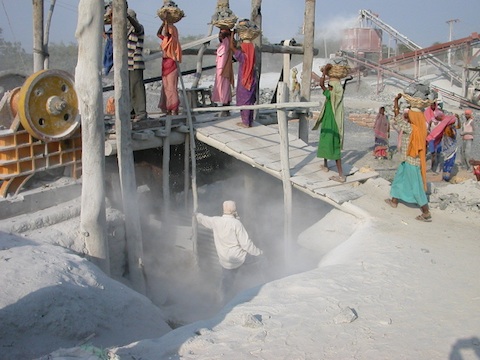
Stone crushing mills have proliferated throughout India to accommodate the huge demand for stone used in road building and construction. Through the efforts of OK International and our Indian partners, air monitoring has determined that exposures to silica are five times the acceptable limit.
Preventing Silicosis Among Stone Crusher Workers
Thousands of poor, often indigenous women and children are exposed to clouds of airborne silica from quarry and stone crushing operations. Many of the most highly exposed are children working and living next to these mills. There is also a high incidence of Tuberculosis (TB) among theses communities, compounding the health impacts of silica exposure.
In partnership with the organizations listed below, OK International is working in the States of Orissa and Karnataka, India to encourage stone crusher mill owners to install pollution control equipment and take precautions to lower occupational exposures to silica. Project activities include outreach in the form of health and safety trainings to mill owners, managers, and workers, and technical training on engineering controls.
In addition to providing training and technical assistance on the dust reducing water spray systems, we are also working with mill owners to demonstrate how rainwater harvesting can supply the water needed for dust suppression equipment.
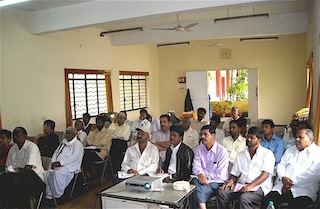
OK International and Best Practices Foundation conduct a training course with stone crusher mill owners on dust control measures.
A safety manual in the Kannada language has been created as part of this project to educate mill owners and operators about the hazards of silica dust and methods to reduce exposures.
Locations in India:
- Karnataka, Dharwad Area
- Orissa, Jajpur District
Partner Organizations:
- Best Practices Foundation
- Jeevan Rekha Parishad (JRP)

OK International conducts a training course in Ho Chi Minh City on reducing lead exposures from battery manufacturing and recycling facilities.
Improving the Lead Battery Industry
The manufacturing of lead batteries in developing and newly industrialized countries, as well as the informal collection and recycling of used lead batteries in unregistered smelters, releases large quantities of lead into the environment. These exposures result in significant health impacts to workers and children in affected communities. The lead battery industry in Asia is growing rapidly yet there are few technical experts in many of these countries working on improving environmental controls for these facilities. To encourage improvements in the lead battery industry, we conduct trainings and outreach in addition to providing technical assistance to battery manufacturers, government agencies, and vehicle manufacturers.
OK International provided technical assistance to the Vietnam Environmental Administration (VEA) on environmental controls, occupational health measures, and the management of used lead batteries. In April 2009, we organized a two-day training in Ho Chi Minh City for battery manufacturers and government officials on safe work practices, air monitoring techniques, emissions controls and related topics.

With the implementation of occupational control measures, lead battery manufacturers can reduce exposures in their facilities.
In China, OK International partnered with the Vehicle Emission Control Center of the Ministry of Environmental Protection (VECC-MEP) and the China Automotive Technology & Research Center (CATARC), to raise awareness of the hazards of lead battery manufacturing and recycling. This cooperation was aimed at encouraging improvements in these industries. A conference organized by OK International and VECC in September 2010 addressed China’s policies and regulations on lead battery recycling. The conference was attended by key stakeholders from industry and government. Since then the Government has closed hundreds of lead battery recycling and manufacturing plants and there has been significant reductions in overall lead emissions. However, on average the remaining lead battery manufacturing plants in China have 1/10th the production capacity but twice the lead emissions as do plants in the U.S.

Addressing Lead Paint in Cameroon
Much of the new paint manufactured and sold in African countries contains high levels of lead. Exposure to lead in paint is caused as the paint deteriorates and lead dust settles in and around the home. Children are extremely susceptible to exposure as they have frequent hand-to-mouth contact and play close to the ground where paint dust collects. Workers are exposed from manufacturing lead paint and from disturbing lead paint during construction and renovation activities.
OK International is working in partnership with the Research and Education Centre for Development (CREPD) to evaluate lead concentrations in consumer paints, work with industry to seek alternative formulations, and disseminate educational materials on lead hazards in Cameroon. This project is intended to provide the foundation for the phasing-out of lead based paints in Cameroon. We believe this project can serve as an excellent pilot for similar national programs throughout Africa. This project is being funded under the UNEP Quick Start Programme.
Location: Yaoundé, Cameroon
Partner Organization: Research and Education Centre for Development (CREPD)
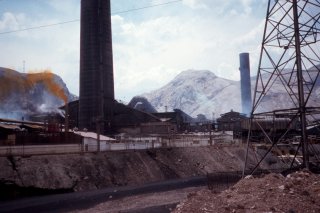
The U.S. owned smelter in La Oroya, Peru has been operating for over 80 years causing heavy metal contamination throughout the city.
Heavy Metal Contamination From a U.S. Owned Smelter in Peru
The town of La Oroya, Peru - the site of an American owned smelter - is suffering from decades of unregulated emissions from the plant which continue to this day. According to the Peruvian Ministry of Health, blood lead levels among local children are dangerously high averaging 33.6 micrograms/deciliter, triple the World Health Organization limit of 10 micrograms/deciliter, while the vegetation in the surrounding area has been destroyed by acid rain. Limited environmental sampling has revealed lead levels exceeding public health standards in almost 90 percent of the homes, extensive soil contamination, and excessive airborne emissions throughout the town.
Lead causes a range of health effects, but primarily effects neurological development in children resulting in reduced school performance, lower scores on standardized tests (such as IQ), mental retardation and can even cause death. A significant portion of those tested by the Ministry of health should have received immediate medical attention to remove lead from the body, but no follow-up was ever initiated.

Toxicologist Kathryn Dowling of OK International conducts a training program on lead hazards for health practitioners and community organizations in La Oroya, Peru.
To plan for remediation and to examine the potential for ongoing exposure from the lead and other metals already deposited in La Oroya, further testing of dust lead levels inside homes was required. We therefore brought the equipment and supplies and trained our partners at the Asociación Civil Labor to collect dust wipe samples. We then arranged for half the samples to be analyzed at a laboratory in the U.S. as a donated service. After obtaining the results, we worked with our Peruvian partners to prepare a report, and conduct education and outreach about the health risks associated with the exposure to lead and other pollutants.
Full report in PDF format: [English] [Spanish]
Location: La Oroya, Peru
Partner Organization: Asociación Civil Labor
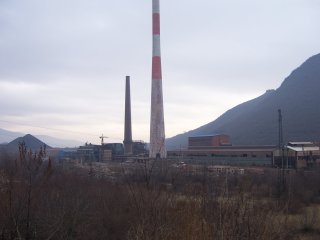
Mitrovica, the site of the second largest smelter complex in Europe, produced lead, arsenic and cadmium from the 1930s until 2000.
Responding to Environmental Lead Pollution: Training Local Health Officials
The World Health Organization (WHO) requested OK International to go to Kosovo in response to the human tragedy left behind by an old industrial site in the former Yugoslavia. Mitrovica, the site of the second largest smelter complex in Europe, produced lead, arsenic and cadmium from the 1930s until 2000 when it was shut down by foreign peacekeepers to stop additional pollution coming from the plant. A second complex South of the town producing lead batteries was also shut down. (See the photograph.)
Around 2001 it became apparent that a large number of Roma (Gypsy) children, displaced during the war and relocated to a refugee community on top of the smelter tailings, were experiencing lead poisoning. Subsequently WHO got involved and conducted studies demonstrating extensive environmental pollution and human exposure. The organization continues to play a major role in cleaning up the legacy of the smelter in Mitrovica.

Perry Gottesfeld of OK International conducting a Lead Risk Assessment training class for local health officials.
Although the Roma refugees were moved in 2004 to a near by location, their new homes were also located on top of extensively contaminated tailings. The newer structures are of better quality and provide some small help in keeping out lead contaminated dust and soil. But children and adults in this community and throughout other areas of Mitrovica are continuing to experience extremely high rates of lead poisoning. OK International conducted an in-depth training class for local health officials on how to test, characterize, and respond to lead hazards in the environment.
